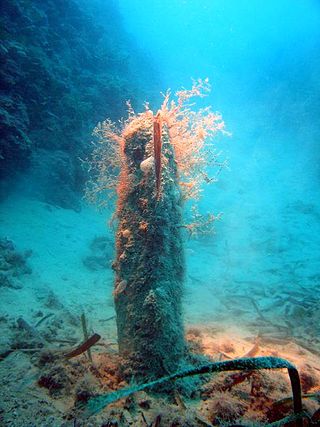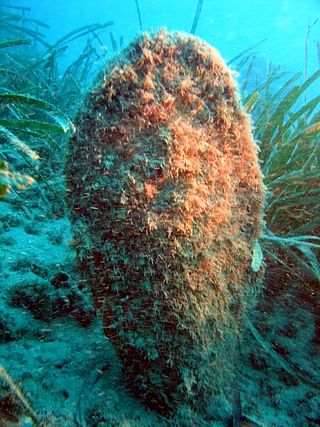
Bivalvia, in previous centuries referred to as the Lamellibranchiata and Pelecypoda, is a class of marine and freshwater molluscs that have laterally compressed bodies enclosed by a shell consisting of two hinged parts. As a group, bivalves have no head and they lack some usual molluscan organs, like the radula and the odontophore. The class includes the clams, oysters, cockles, mussels, scallops, and numerous other families that live in saltwater, as well as a number of families that live in freshwater. The majority are filter feeders. The gills have evolved into ctenidia, specialised organs for feeding and breathing. Most bivalves bury themselves in sediment, where they are relatively safe from predation. Others lie on the sea floor or attach themselves to rocks or other hard surfaces. Some bivalves, such as the scallops and file shells, can swim. Shipworms bore into wood, clay, or stone and live inside these substances.

A byssus is a bundle of filaments secreted by many species of bivalve mollusc that function to attach the mollusc to a solid surface. Species from several families of clams have a byssus, including pen shells (Pinnidae), true mussels (Mytilidae), and Dreissenidae.

Sea silk is an extremely fine, rare, and valuable fabric that is made from the long silky filaments or byssus secreted by a gland in the foot of pen shells. The byssus is used by the clam to attach itself to the sea bed.
A molluscivore is a carnivorous animal that specialises in feeding on molluscs such as gastropods, bivalves, brachiopods and cephalopods. Known molluscivores include numerous predatory molluscs,, arthropods such as crabs and firefly larvae, and, vertebrates such as fish, birds and mammals. Molluscivory is performed in a variety ways with some animals highly adapted to this method of feeding behaviour. A similar behaviour, durophagy, describes the feeding of animals that consume hard-shelled or exoskeleton bearing organisms, such as corals, shelled molluscs, or crabs.

Atrina fragilis, the fan mussel, is a species of large saltwater clam, a marine bivalve mollusc in the family Pinnidae, the pen shells.

The Pinnidae are a taxonomic family of large saltwater clams sometimes known as pen shells. They are marine bivalve molluscs in the order Pteriida.

Perna perna, the brown mussel, is an economically important mussel, a bivalve mollusc belonging to the family Mytilidae. It is harvested as a food source but is also known to harbor toxins and cause damage to marine structures. It is native to the waters of Africa, Europe, and South America and was introduced in the waters of North America.

Pinna is a genus of bivalve molluscs belonging to the family Pinnidae.

Atrina is a cosmopolitan genus of bivalve molluscs belonging to the family Pinnidae.

Atrina rigida, commonly called the rigid pen shell, is a species of bivalve mollusc in the family Pinnidae.

Pinna nobilis, whose common name is the noble pen shell or fan mussel, is a large species of Mediterranean clam, a marine bivalve mollusc in the family Pinnidae, the pen shells.

The Mediterranean mussel is a species of bivalve, a marine mollusc in the family Mytilidae. It is an invasive species in many parts of the world, and also an object of aquaculture.

Panulirus pascuensis is a species of spiny lobster found around Easter Island and the Pitcairn Islands in the Pacific Ocean. It is known in English as the Easter Island spiny lobster, Langosta de Isla de Pascua in Spanish and Ura in the Rapa Nui language. This lobster is fished on a small scale for local consumption.

Pinna carnea, commonly called the amber pen shell, is a species of bivalve mollusc in the family Pinnidae.

Novocrania anomala is a species of brachiopod found offshore in the eastern Atlantic Ocean.

The umbo is the vaguely defined, often most prominent, highest part of each valve of the shell of a bivalve or univalve mollusc. It usually contains the valve's beak, the oldest point of the valve, and its degree of prominence and position relative to the hinge line are sometimes helpful in distinguishing bivalve taxa. The umbo forms while the animal is a juvenile, and radial growth subsequently proceeds around that area. The umbo is situated above the hinge line. In those bivalves where the umbones do not protrude, as is the case for example in some mussels, the umbones can nonetheless usually be readily identified by examining the concentric growth lines of the shell.

Lasaea rubra is a species of small marine bivalve mollusc in the family Lasaeidae. It is found on the eastern side of the Atlantic Ocean. This species was first described in 1803 by the English naturalist George Montagu who gave it the name Cardium rubrum. It was later transferred to the genus Lasaea, making it Lasaea rubra.

Pinna bicolor, also known as razorfish, razor clam, or pen shell, is a species of large saltwater clam in the family Pinnidae. It is commonly found in shallow waters up to 50 m (160 ft) deep. It can be found embedded in firm muddy intertidal sediments, seagrass beds, and reef flats along continental and island shores.



















